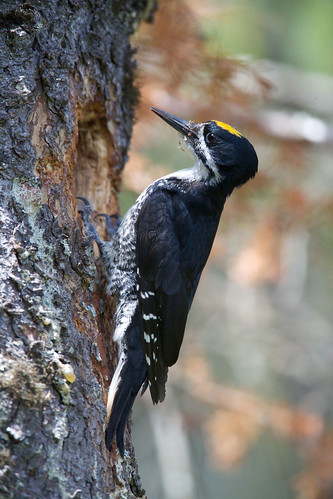
Following a wildfire, some might see dead trees. Woodpeckers see possibilities.
The black-backed woodpecker is one such bird—a burned forest specialist—who readily chooses fire-killed trees (snags) in which to drill cavities for nesting and roosting.
When the woodpecker moves on, its cavity turns into valuable habitat for other forest-dwelling species.
Researchers from the U.S. Forest Service Pacific Southwest Research Station (PSW) studied how these habitat contributions from black-backed and other woodpeckers aid the restoration of a recently burned forest. Their findings were recently published in the Journal of Zoology.
The researchers located 77 nests of three woodpecker species (black-backed, white-headed, and hairy) in snags resulting from the 2007 Angora Fire near Lake Tahoe, California. More than 85 percent of the nest cavities were used by other animals within the first year after excavation, and researchers detected a wide array of secondary cavity users, including other birds and small mammals, that disperse seeds for germination, keep insect populations in check, and serve as food sources for carnivores during post-fire forest regeneration.
“Woodpeckers are important ecological engineers, but most previous research has focused on their role in green, unburned forests,” said Gina Tarbill, a PSW research fellow from the Department of Energy’s Oak Ridge Institute of Science and Education and the study’s lead author. “Our research finds that woodpeckers play a key role in providing cavities that enable occupancy and use of the burned forest by other species which in turn contribute to a variety of ecosystem functions and services.”
While cavity characteristics were similar among the three woodpecker species, researchers found that black-backed woodpeckers selected nest sites in the densest stands of dead trees. (Hairy woodpeckers selected moderately dense stands, and white-headed woodpeckers selected the least dense stands.) Black-backed and hairy woodpeckers tended to select taller, less decayed trees with smaller diameters. White-headed woodpecker cavities supported the greatest diversity of secondary cavity users, followed by black-backed and hairy woodpeckers, respectively. Two years after the fire, half of the snags with cavities had fallen.
Across burned landscapes, the continued presence of woodpeckers ensures that new cavities are available for secondary cavity users who play a part in forest regrowth. Managers can support a diversity of woodpeckers, including non-burned forest specialists, by leaving a range of snag densities and sizes. And in California’s Sierra Nevada region where researchers are concerned about the limited amount of suitable habitat for black-backed woodpeckers, managers can take more specific actions.
“Generally, black-backed woodpecker populations decrease to low levels five to seven years after a fire,” said Pat Manley, PSW’s Conservation of Biodiversity Program Manager who collaborated with Tarbill on the study. “Our results suggest that retaining higher densities of small diameter snags could benefit the black-backed woodpecker in the Sierra Nevada.”
Long after the woodpeckers have moved on, the legacy of their work will be seen in the new green of a recovering, resilient forest.
